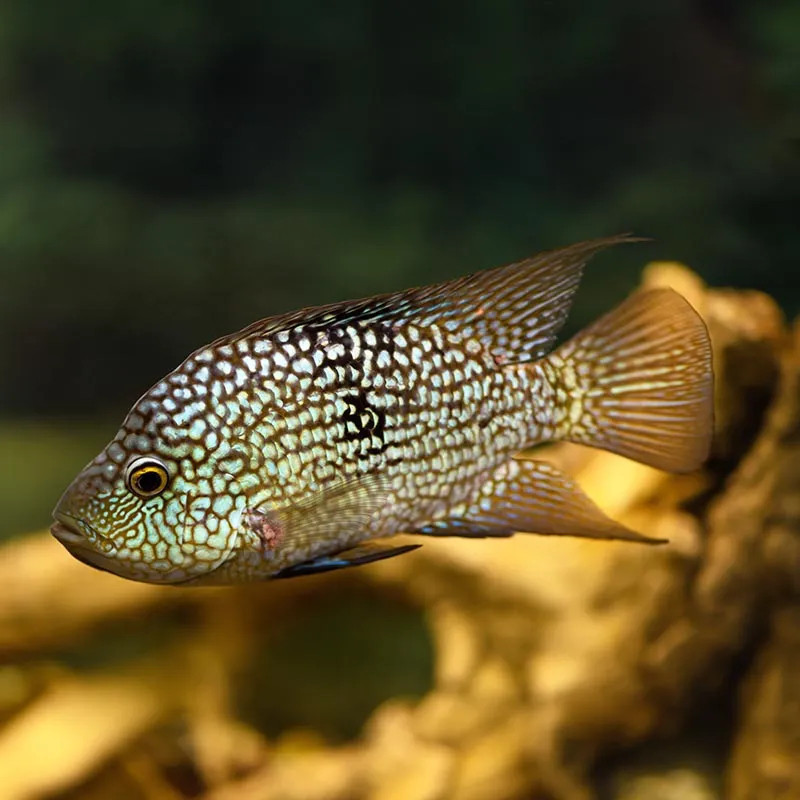Stocks Available
VENUSTUS
SKU:118894
NIMBOCHROMIS VENUSTUS
4 CM

Stock Available
Introduction: • Common Names: Texas Cichlid, Blue Spotted Cichlid • Natural Habitat: Native to the freshwater rivers and lakes of Texas and Mexico, particularly in warm, slow-moving waters with ample vegetation. Physical Characteristics: • Appearance: Features a robust, oval-shaped body with a striking pattern of blue or turquoise spots on a green or brown background; fins are elongated with a colorful edge. • Size: Typically grows to about 8 to 12 inches (20 to 30 cm) in length, depending on the environment and diet. • Lifespan: Can live for 10 to 15 years when provided with proper care and conditions. Habitat Requirements: • Tank Size: Requires a minimum of 50 gallons for optimal space; larger tanks are preferable for adult specimens. • Water Conditions: o Temperature: Thrives in warmer waters, ideally between 76-82°F (24-28°C). o pH: Prefers a pH range of 7.0 to 8.0, simulating its natural alkaline habitat. • Aquascaping: Incorporate plenty of hiding spots using rocks, caves, and driftwood, along with plants that can withstand its territorial nature. Diet: • Primary Diet: Omnivorous; in the wild, feeds on small invertebrates, insects, and plant matter. • Supplemental Feeding: Offer high-quality cichlid pellets, flakes, and occasional live or frozen foods like bloodworms, brine shrimp, and vegetable matter. • Feeding Frequency: Feed once or twice daily, providing only as much food as they can consume in a few minutes. Compatibility: • Temperament: Semi-aggressive; can be territorial, especially during breeding and when establishing dominance. • Suitable Tank Mates: Compatible with similarly sized cichlids and other robust fish; avoid small or timid species that may become targets. • Incompatibilities: Not suitable for peaceful community tanks with smaller or less aggressive fish that may be harassed. Care Level: • Difficulty: Moderate; requires careful attention to water quality and social dynamics within the tank. • Health Monitoring: Regularly check for signs of stress or illness, particularly during breeding, when they may become more aggressive. Breeding: • Breeding in Captivity: Relatively straightforward; pairs often form strong bonds and exhibit protective behaviors towards their young. • Spawning: Egg layers; females typically lay eggs on flat surfaces, and both parents can help care for and guard the fry. Economic Considerations: • Market Demand: Popular among cichlid enthusiasts for their vibrant appearance and interesting behaviors. • Wholesale/Retail Pricing: Generally affordable, but prices may vary based on size and coloration. Sustainability and Conservation: • Wild Population: Populations are generally stable, though local habitat destruction can impact numbers. • Aquaculture Efforts: Commonly bred in captivity, helping reduce pressure on wild populations and providing options for aquarium hobbyists. • Regulations: Ensure compliance with local laws regarding the trade and keeping of cichlids. Conclusion: The Texas Cichlid is a striking and engaging addition to freshwater aquariums, admired for its beauty and personality. With proper care and understanding of their specific needs, they can thrive and provide enjoyment for cichlid enthusiasts and hobbyists alike.
Data sheet
7 other products in the same category:
Customers who bought this product also bought: